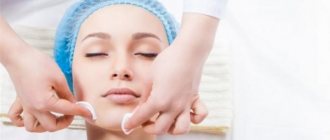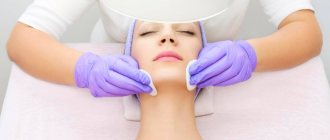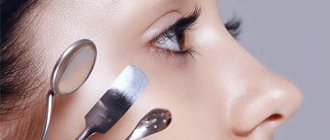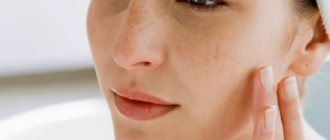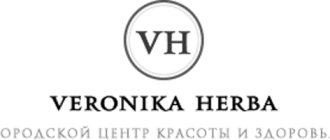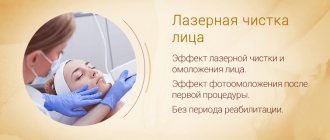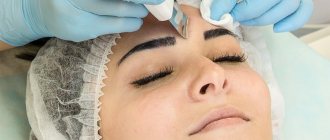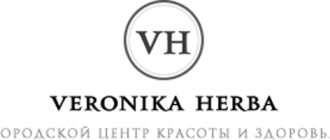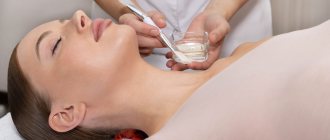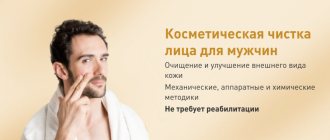Pros and cons of mesotherapy
Mesotherapy demonstrates an integrated approach to solving aesthetic and age-related skin problems. It works in two directions at once:
- ensures the delivery of beneficial biologically active substances and cocktails directly to the skin;
- through the mechanical action of the needle, it stimulates cellular activity, the processes of natural regeneration and renewal.
During the procedures, medications relevant to the client are administered in strictly dosed quantities and to the required depth. They do not act on the entire body, but exclusively locally - on the problem and the reasons for its occurrence. Thanks to this, the necessary effect of correction, rejuvenation or healing is achieved in a minimum number of procedures and with a guarantee of long-term positive results.
Despite the fact that the technique involves injections, mesotherapy is the most physiological procedure for the human body. Indeed, during its implementation, our skin receives vital vitamins, acids, nutrients, moisturizing and other beneficial substances, as well as active stimulation of its internal reserves to launch self-renewal mechanisms. The advantages of this approach to solving cosmetic problems are obvious:
- maximum effectiveness of procedures;
- minimal trauma and pain;
- the versatility of the technique - it is effective regardless of the complexity of the problems, the patient’s age, skin type, lifestyle and time of year;
- very short recovery period – 1 – 2 days;
- long-term positive result of transformation;
- minimal risk of side effects and complications.
Mesotherapy has no absolute contraindications. The only negative is the presence of relative restrictions on the procedures. It is better to refrain from beauty injections in the following cases:
- with renal or liver failure;
- during pregnancy and lactation;
- during systemic administration of anticoagulants;
- with a predisposition to the formation of keloid scars;
- during periods of exacerbation of chronic or seasonal diseases;
- in the presence of malignant tumors.
Mesotherapy can be performed independently or in combination with other cosmetic procedures. Peels, masks, massages, wraps, cavitation, radio wave lifting and other techniques will help enhance its effectiveness and consolidate the achieved results.
Mesotherapy is not scary and not dangerous to health. With its help you can get rid of an impressive list of aesthetic and age-related problems. Direct indications for the procedures are:
- signs of photoaging – pigment spots, dryness, defects of small vessels;
- age-related changes - wrinkles, sagging, creases, decreased skin tone;
- aesthetic defects – post-acne, scars, stretch marks;
- stagnation in tissues - swelling, puffiness of the face, bags under the eyes;
- dysfunction of the structural components of the skin - increased secretion of sebum, acne, redness, itching;
- pathological changes in subcutaneous fat – cellulite, local fat deposits, double chin;
- scalp problems – fragility, dryness, hair loss, dandruff, seborrhea, alopecia;
- dermatological problems - dermatosis, psoriasis, dermatitis (for medical reasons), etc.
Mesotherapy helps prepare the skin of the face and body for “aggressive” cosmetic procedures (chemical peeling, dermabrasion, laser resurfacing), and also accelerates its recovery after them. This is a unique technique in its capabilities and effectiveness that will help you achieve healthy, smooth, youthful-looking skin and a beautiful body. With its help you can look attractive at any age.
How and on what areas is mesotherapy performed?
We carry out the procedure:
- in perfectly sterile conditions;
- after a detailed study of the client’s medical history, the complexity of his aesthetic, age-related problems and making an accurate diagnosis;
- only with the involvement of a certified cosmetologist.
Preparations for subcutaneous and intradermal injections are selected individually, taking into account their effectiveness, safety, individual tolerance and financial capabilities of our client. A thorough, responsible, and most importantly professional approach allows you to get a predictable result that will please you for a long time.
You can entrust the specialists of our clinic with a problem of any localization - we perform mesotherapy on the face, neck, décolleté, hands, body, and scalp.
To solve this problem, we use classical beauty injection techniques:
- mesopuncture;
- mesoinjections;
- nappage;
- mesoinfiltration;
- superficial or deep papules;
- mesoperfusion.
As well as innovative hardware techniques:
- fractional mesotherapy,
- mesotherapy using a nanocolloid generator,
- non-injection oxymesotherapy.
Our cosmetologist will always tell you in more detail about what manipulations will be carried out specifically in your case during the initial consultation.
The mesotherapy procedure itself, which consists of giving injections, involves an extremely simple protocol of actions:
- cleansing the affected area;
- skin disinfection;
- use of local anesthesia;
- repeated cleansing and disinfection of the skin;
- giving injections;
- soothing and restorative care.
After the treatment is completed, you will receive useful recommendations for caring for your face, body or scalp (depending on where the procedure was performed) and can safely go home.
What does the price of the procedure depend on?
The price of mesotherapy is determined by four factors:
- total area of the treated area;
- the amount of vitamin, anti-aging or other drugs administered;
- prices of the cocktails or individual substances used;
- complexity of the injection technique.
In addition, it is necessary to take into account the total number of procedures within one course.
Indeed, to obtain a sustainable positive result, 2–3 or 5–10 treatments may be required, which will naturally affect the final price of the course. However, this is not a financial expense! A rational investment in your own health, beauty and youth. And they will pay off not over time, but right now - already during the first mesotherapy procedures. Author: Khazova Alla Sergeevna
Benefits of technology
- non-traumatic: the absence of mechanical impact eliminates the possibility of pigmentation;
- hardware cleaning does not injure blood vessels and does not leave noticeable marks on the skin;
- hygiene;
- uniform and gentle cleansing of the skin;
- removal of excess sebum, dead cells, impurities;
- possibility of carrying out even for those with thin and sensitive skin;
- compatibility with other types of cosmetic procedures - for example, peeling;
- You can start doing ultrasonic cleaning as early as adolescence;
- With regular ultrasonic cleaning, a complex effect is observed.
It is recommended to do ultrasonic cleaning once every 1-3 months, depending on the condition of the skin. The procedure does not last long, is painless and does not require rehabilitation, which is also an undeniable advantage of the technology.
Expectant mother at the cosmetologist
During pregnancy, a woman's body undergoes changes that help it adapt to pregnancy and childbirth. The ratio of hormones changes, the volume of circulating blood increases, body proportions change, etc. The task of a cosmetologist is to help the expectant mother cope with possible aesthetic problems.
Most often, we encounter complaints about dry skin, its lack of elasticity, leading to the appearance of stretch marks in areas of rapid volume change (chest, abdomen, buttocks), and swelling of the legs.
The best option for providing cosmetic services to a pregnant woman is when the cosmetologist takes into account the pregnancy history and concomitant pathology. It is advisable to listen to the opinion of the obstetrician-gynecologist supervising your patient.
Swelling of the legs may be physiological due to a violation of the outflow through the veins, because an enlarged uterus “pinches” the vessels, and is also a symptom of varicose veins, kidney disease, and toxicosis. It is important to correctly assess the situation so as not to harm the expectant mother.
Cosmetic manipulations and products used during this important period should be as delicate as possible, non-toxic, and not affect hormonal levels and uterine tone. For example, drugs containing large quantities of iodine can cause an attack of tachycardia and even thyrotoxicosis: placental hormones increase the sensitivity of the thyroid gland to TSH, therefore during pregnancy the activity of the thyroid gland increases, it becomes sensitive to fluctuations in iodine in the body.
Magnetic fields and electric currents are contraindicated for pregnant women: they can generally disrupt the formation of the fetus and provoke an increase in the tone of the uterus. The tone of the uterus can also be affected by pain that requires the patient to concentrate tension: injections, laser and phototherapy, some essential oils.
Cold procedures (such as body wraps) should be avoided as they may aggravate kidney and urinary tract infections.
The most popular procedures:
- Moisturizing
, skin-strengthening wraps (especially in areas at risk of stretch marks). These can be mud, peat applications of masks and creams, strengthening patches, herbal preparations, etc. Chocolate wrap is especially popular: the skin becomes soft, silky, and the smell of chocolate stimulates the production of endorphins and helps improve the mood of the pregnant woman;
- Lymphatic drainage
to improve venous outflow and microcirculation.
For pregnant women, manual lymphatic drainage and endermological lymphatic drainage using an LPG machine are recommended.
The latest method of lymphatic drainage allows you to both solve the problem of edema and strengthen the skin, prevent cellulite, and relieve pain in the lumbar region.
One of the common aesthetic problems of pregnant women is the appearance of hyperpigmented spots on the face (chloasma, “mask of pregnant women”). Ultraviolet and solar radiation can be an impetus for their appearance or enhance existing pigmentation. The reason is the hormonal background of a pregnant woman. Chloasma occurs regardless of the use of sunscreen. Trying to whiten pigmentation is ineffective and dangerous by increasing melanogenesis in the skin. It is recommended to use prophylactic agents that block melanin synthesis - these are drugs containing ascorbic, kojic and phytic acids. Procedures carried out in the salon must be complemented by systematic home care.
Before a cosmetic procedure, you should ask about the client’s attitude to the smells of cosmetic products. During pregnancy, the sense of smell becomes more acute, and the reaction even to ordinary odors can be excessive, even to the point of vomiting.
Vascular strengthening procedures are useful for pregnant women, because... they have a tendency to develop a network of dilated capillaries on the street. For this purpose, vitamins K, C, P, arnica, mimosa, thermal waters, and some mud are used. Alginate masks have a good vascular tonic effect.
During pregnancy, antiviral immunity decreases. This is manifested by an exacerbation of herpes and the appearance of a large number of papillomas (especially in places where clothing rubs). It is unsafe to use antiviral drugs during this period. You can increase skin immunity by using cosmetics with vitamin C, and you can dry herpes blisters with mash, lotions, and emulsions containing zinc. It is not advisable to remove papillomas, because Without the use of antiviral drugs, new rashes appear, and after the birth of the child, all papillomas disappear on their own.
Pregnant women often complain about deteriorating hair quality, despite taking vitamins regularly. In such cases, a massage of the head and collar area, masks that strengthen the hair follicles, vitamin shampoos and lotions are useful.
Facial cleansing during pregnancy
It is impossible to say in advance how safe ultrasonic cleaning will be for the patient. This procedure is not traumatic, does not involve violating the integrity of the skin or introducing a particular composition under the skin.
However, risks are always present. If possible, it is better to avoid ultrasound until after breastfeeding. But if you really want to, you need to talk to a gynecologist. In the early stages and mid-pregnancy, ultrasound cleaning is possible for some women.
If the period is late (8-9 months), cleaning cannot be carried out, at least for the reason that the woman will have to remain motionless for a long time. And this is strongly not recommended.
There are different types of facial cleansing: for example, laser, chemical, ultrasonic cleansing. The highest quality and most useful during pregnancy of any stage is ultrasound facial cleansing. Massage from the influence of ultrasound waves improves skin elasticity and enhances interaction with cosmetics. However, a pregnant woman should consult a gynecologist on the eve of the procedure to exclude possible individual contraindications.
Author: Ekaterina Nikolaevna Kozlova
Pregnancy in questions and answers
What should we expect? How to eat? How to deal with difficulties? How to do everything right? Irina Aleksandrovna Soleeva, an obstetrician-gynecologist at the Sadko clinic, will answer these and many questions.
— How is the due date calculated?
From the first day of the last menstruation. To determine the due date, 280 days are added to the first day of the last menstruation, i.e. 10 obstetric, or 9 calendar, months.
Usually, calculating the due date is simpler: from the date of the first day of the last menstruation, count back 3 calendar months and add 7 days. So, if the last menstruation began on October 2, then by counting back 3 months (September 2, August 2 and July 2) and adding 7 days, the expected date of birth is determined - July 9; if the last menstruation began on May 20, then the expected due date is February 27, etc.
The expected due date can be calculated by ovulation: from the first day of the expected but not occurring menstruation, count back 14-16 days and add 273-274 days to the found date.
- And if you know the exact date of conception, then how many days should you add?
A large-scale study was conducted with a large number of pregnant women; the duration of pregnancy and, accordingly, the date of birth were determined using various indicators. It turned out that women most often remember the date of their last menstruation. And from this fixed date, as the study showed, childbirth occurs at the 40th week ± a couple of weeks. Obstetricians-gynecologists are guided by this calculation system.
— Is it worth changing your diet, if so, how?
In the first half of pregnancy, 4 meals a day are recommended, in the second half - 5-6 meals a day. It is better to eat often, but little by little. For healthy women there are no prohibited foods (except for alcoholic beverages), there are only more or less preferable ones.
Thus, the body better absorbs easily digestible milk fats and vegetable oils. The latter are not only a source of essential linoleic acid, but also vitamin E, which has a positive effect on the course of pregnancy.
To prevent constipation, it is worth enriching your diet with sources of dietary fiber (fiber, pectins) - vegetables and fruits, buckwheat and oatmeal.
In the second half of pregnancy, it is advisable to eat sugar, confectionery and flour products, and rice in very small quantities. You should not get carried away with fried, spicy, salty foods, because... During this period, the liver and kidneys of the pregnant woman function under strain. It is better to prefer boiled and steamed dishes.
The main thing is to include a variety of foods in your diet: vegetables, fruits, juices - and you will provide yourself and your unborn child with everything necessary for normal development.
— I really want olives, but they are canned. Can?
It depends on the stage of pregnancy. After 20 weeks, I would not recommend eating too salty foods, including olives. And in general, any canned food is not the most suitable food for a pregnant woman. Although olives themselves are a very healthy product. Therefore, within reasonable limits, say, you can eat a jar in two days.
- And the grapes?
Grapes are very well digestible. This is fructose. It is immediately absorbed and quickly increases blood sugar. But if you are overweight, it is either not recommended at all or allowed in small quantities. You can eat a small brush, but you can also treat yourself to something else.
For some reason, it is generally accepted among us that if you are pregnant, you have to eat for three or whatever you want. As a result, pregnant women buy boxes of grapes and eat kilos of them. Such a diet does not lead to anything good: sugar appears in the urine, blood sugar rises, and babies are born large. Moreover, a large load falls not only on the mother’s pancreas, but also on the child’s pancreas - the baby will be predisposed to excess weight from birth.
— Is it possible to lose excess weight during pregnancy and cleanse your body with the help of special teas?
All cleansing teas are contraindicated during pregnancy. We have drugs that improve liver and kidney function and have a diuretic effect. We assign everything individually. No special cleansing procedures are performed during pregnancy. However, we have fasting days - here is the best cleansing procedure for you.
— What vitamins are best to choose during pregnancy?
Nowadays there is a huge selection of different vitamin complexes for pregnant women. Of course, they are all close to each other in composition. One or two components or the dosage of a certain vitamin differ. In order not to harm yourself and the baby, and to achieve maximum effect, each patient needs to select vitamins, based on the advice of her doctor, who monitors the course of pregnancy.
— How long to take them?
Multivitamin preparations cannot be taken continuously. Only a doctor can select the required course, taking into account the condition of your body. We have different periods when it is better to stop taking vitamins altogether. In certain weather seasons, when there is enough sun, fresh vegetables and fruits, there is no need to take vitamin complexes.
— Is it possible to continue playing sports?
Not only is it possible, but it is also necessary. From the first months of pregnancy. They will help you maintain good physical shape, and this will definitely help during childbirth, relieve unnecessary tension and improve your mood. The main thing that should not be forgotten is that the training program must be specially adapted for pregnant women and should be carried out under the supervision of a doctor or an experienced instructor.
— Do you really need to push during childbirth classes? Will diligence create a danger of premature birth?
No, there is no danger in this exercise. If there is anything you need to be careful of, it is cycling, horse riding, roller skating - all sports with an increased risk of injury.
— Is it possible to take a contrast shower?
Can. If a woman used this procedure before pregnancy. But during pregnancy, the water should not be too hot. By the way, hot baths and saunas should also be excluded.
— Is it possible to continue to have sex during pregnancy?
Each couple decides for themselves. If both enjoy it, if the woman is comfortable, then you can maintain sexual activity almost until childbirth. Of course, you will have to exclude too active sex, and stop altogether 2-3 weeks before giving birth: too vigorous sexual intercourse can provoke premature birth.
If earlier it was very strict: sexual life ceases from 30-32 weeks, but now sexual life is excluded by the doctor only if there are any deviations. After a while, he may allow intimacy to resume. There are cases when sexual activity is excluded for the entire 40 weeks.
— Do I need to use protection during pregnancy to avoid getting pregnant again?
Very funny question. If one pregnancy has already occurred, reconception cannot occur during this period. The need for protection therefore disappears.
— Is it possible to sleep on your stomach?
On short notice it is possible. The uterus emerges from the pelvic cavity after 12-13 weeks. Before this, it is protected by the pelvic bones, which means that we will not cause any harm to the fetus.
- So, the job of the expectant mother. Should you reconsider your workday taking into account the new condition?
Working during pregnancy is completely acceptable if no abnormalities are observed. It is important to remember that pregnant women should not lift heavy objects or work in hot or high humidity conditions. Contact with harmful substances and prolonged standing should be avoided.
— Can motorists continue to drive?
You can drive a car if there are no contraindications from the doctor who is monitoring you during pregnancy. And it is not advisable in the later stages after 30 weeks, because there is a very strong load on the pelvic floor muscles, the legs and arms work, concentration of attention is required - this is an additional stressful situation for your body. And of course, don’t neglect your seat belt. It will not pull over your stomach, but will pass under it and under your arm diagonally.
— How to deal with the signs of varicose veins?
It depends on the degree of varicose veins and its severity. Despite the wide selection of various internal and local drugs - tablets, drops, ointments - the most effective method of combating is, nevertheless, wearing compression garments. By the way, those who spend most of their working time sitting at a desk, or, on the contrary, standing on their feet, should also think about the prevention of varicose veins.
It’s better to choose tights: elastic knee socks or stockings compress the leg too much, and when bandaging your legs, it’s difficult to determine the necessary compression.
Tights should be selected from a doctor. A phlebologist works in our clinic. He will be able to select the required degree of compression.
Don’t be afraid that the underwear will be too tight for both your legs and stomach: there are special tights for pregnant women. A special insert on the stomach fits it, supporting it, without squeezing it at all.
— What should smokers do: won’t giving up a bad habit cause stress on the body if their smoking history before pregnancy was quite long?
Smoking during pregnancy is very bad. This applies equally to active and passive smokers. The fetus develops chronic hypoxia - a constant lack of oxygen. And it primarily affects the development of brain structures. The consequence is deviations from the norm in mental development. Even if the disturbances are minor at first, in infancy they are most likely to appear in kindergarten or school, when the maximum load is placed on the child’s intelligence. It will be difficult for the baby to learn and perceive any information.
Moreover, the threat of premature birth and miscarriages at different stages of pregnancy is growing. Children are often born low birth weight.
Stories that quitting habitual smoking will cause severe stress to the body are far from true. Our patients who are expecting their baby give up this bad habit without much difficulty. Even if you regularly inhaled tobacco smoke both before and after conception, you should not think that it is still too late to quit. The harm you will cause to your baby if you continue to smoke is not comparable to your reluctance to give up your cigarette.
— Where and how to find a qualified doctor who you can trust to take care of yourself and your unborn child?
The Women's Health Center of the SADKO clinic brought together the best specialists of the city: obstetricians-gynecologists, mammologists, ultrasound doctors, therapists, psychologists, physical therapy doctors. Modern equipment in gynecology allows you to accurately and quickly carry out all the necessary diagnostics, and, if necessary, treatment. The advantages of such an integrated approach are obvious: you don’t have to go far, but the main thing is that you are served by one team, one hand. We will be happy to help both expectant mothers and those who really want to become one.
Mesotherapy: history of appearance
The history of cosmetology remembers many interesting cases when important, epoch-making discoveries were made completely by accident. Something similar happened with mesotherapy. Its technology was invented in 1958, when the then unknown doctor Michel Pistor practiced in the small French village of Bre-et-Lue. One of his patients was deaf and suffered from bronchial asthma.
A French doctor gave him an intravenous injection of the anesthetic drug procaine to relieve attacks of suffocation. The treatment did not give the expected result, but the next day the deaf patient reported that he had begun to hear, which surprised the young doctor.
Interested in the achieved effect, M. Pistor repeatedly made attempts to reproduce similar results from the use of procaine with the participation of other patients. Ultimately, he came to the conclusion that intradermal administration of the drug directly into the focus of the pathology or the area adjacent to it has a pronounced effect on the derivatives of the mesoderm, i.e. on the skin, and the effects achieved fall under a new definition - “mesotherapy”.
Continuing to experiment in this direction, M. Pistor published the results of his observations in the authoritative French medical journal “Presse Medicale”, published under No. 44. In his article, the French doctor first described the new method and formulated its basic principles - “rarely, little, in the right place”, which were firmly entrenched in the methodology and became its motto.
For a long time, mesotherapy meant exclusively intradermal injections of procaine. The technique was considered an alternative medicine and was used to relieve spasms and pain. And only the opinion of more authoritative doctors helped bring her to a fundamentally new level of development.
Thus, a significant contribution to improving the method was made by the Spanish master of aesthetic medicine Ignacio Ordiz, who came to the conclusion that during mesotherapy procedures it is possible to administer not only procaine, but also other drugs relevant to the patient.
At the same time, he placed special emphasis on the fact that a positive treatment result is achieved due to a double effect - the pharmacological effect of the administered substances and the stimulating effect of the injections themselves.
French doctor Andre Dalloz-Bourguignon also confidently supported the principles of mesotherapy, noting that it is ideal for administering absolutely any pharmacological substance to achieve the desired effect. And in 1987, mesotherapy was finally officially approved by the Paris Medical Academy of Sciences, after which it quickly found its application in cosmetology and became one of the most popular procedures for maintaining beauty and youth.
